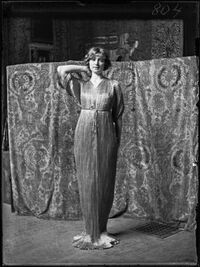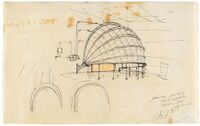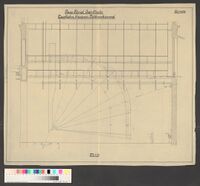Mariano Fortuny y Madrazo was a tailor, fabric and fashion designer, painter, interior designer, engineer and inventor, especially known for his talent in theatrical stage lighting. Fortuny patented more than 20 inventions between 1901 and 1934.
In 1892, after seeing some of Richard Wagner’s (Q30460) operas in Paris, Fortuny (Q231) travelled to Bayreuth (Q7857). He was mesmerised by Wagner’s work and began to paint scenes for his operas when he returned to Venice. In Wagnerian drama, painting, architecture, song, dance, and poetry all worked together towards a common goal. This affected Fortuny’s outlook and was the inspiration for a new type of theatre design where the designer and the technician would work together on a project from idea to realisation. Fortuny and other followers of this concept believed that one can only improve the quality of a product by having a good knowledge of the raw materials and the process of its construction. He also thought that the best type of design was created when the artist knew how to realise the design and controlled all the steps in the creative process.
In collaboration with his French wife Henriette Negrin (1877-1965), an expert in natural dyes, Fortuny invented new methods of textile dyeing and printing on extraordinary fabrics, many with treatments whose secret formula they took to the grave. He adopted forms from antiquity for his designs for women’s dresses. Characteristic of the Delphos dress and the Knossos shawl is the wafer-thin silk satin, permanently pleated and iridescent in the light, which Fortuny patented in Paris in 1909. He founded a silk fabric printing company, the Società Anonima Fortuny, in 1919, and shortly afterwards he opened a boutique in Paris, later adding branches in London, Madrid and, in 1929, New York City. In the 1920s and 1930s, famous actors and dancers such as Sarah Bernhardt, Isadora Duncan, and, in the United States, Martha Graham and Ruth St Denis were his clients.
As a set designer, he wanted to create a more seamless way of transitioning from one scene to another other than flying out a backdrop and bringing in a new one. He began experimenting with light, and found that reflecting light off different surfaces could change its colour, intensity and other properties. His 1904 treatise Eclairage Scenique (‘Stage Lighting’, Q30480) describes the discovery that formed the basis of his indirect lighting technique. He concluded that, ‘it is not the quantity but the quality of light that makes things visible and allows the pupil ... to open properly.’
He used these indirect lighting techniques with massive arc lamps in his invention, the Fortuny cyclorama dome, a half-dome structure of plaster or cloth (B.06). The shape created the appearance of an infinite sky, and could even have moving clouds projected onto it. His first patent, in England in 1901 (Q334), describes a projection device which throws light onto a length of fabric containing all the colours of the spectrum, mounted on rollers. As the fabric to passed in front of the arc lamp, the light reflected from the fabric, creating a source that was indirect, diffuse and coloured, with soft colour transitions. The second patent, applied for and granted in England in 1905, relates to a projection surface intended to represent the sky and its infinity.
During the 1920s, Fortuny’s contribution to the theatre gained widespread recognition. He was soon contracted to install his dome in the famous opera house, La Scala of Milan. He also made it so that the dome was electrically controlled, and could fold and unfold like a giant accordion in the space of 90 seconds. Even more impressively, he invented a suction fan, specifically for this project, which extracted the air from between the two skins of the dome, to keep the inner dome smooth and taut. From the audience’s point of view, this helped the backdrop’s depth to seem almost infinite, as if you were looking at a night sky that never ended.
From the same concept of the dome, Fortuny created a lamp that could be used to recreate indoor lighting onstage, the Fortuny Moda Lamp. Although originally intended for use as a stage lamp and patented in 1903, this lighting fixture remains popular as a floor lamp. Fortuny registered more than fifty patents as an inventor, was involved with indirect lighting effects in the theatre (Fortuny GmbH AEG Berlin), designed theatre sets and costumes and was also represented as a painter at all the Venice Biennales until 1942. He worked in multiple disciplines as a painter, fashion designer, scenographer and inventor, and it was this combination of skills and knowledge, spread as he travelled widely across Europe, that resulted in such a profound impact on theatre practice.



